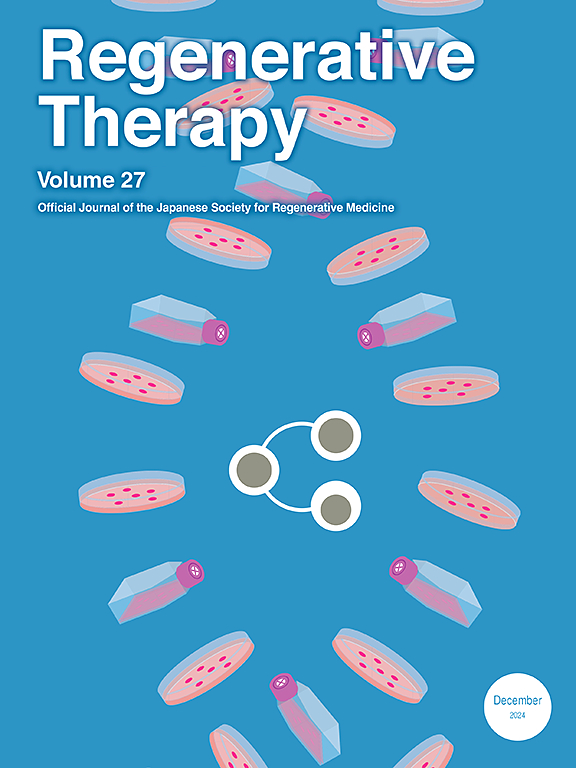mir -145富集的bmscs来源的外泌体通过抑制TGFBR2改善老年大鼠的神经源性勃起功能障碍
IF 3.5
3区 环境科学与生态学
Q3 CELL & TISSUE ENGINEERING
引用次数: 0
摘要
背景:神经源性勃起功能障碍(ED)是老年患者根治性前列腺切除术后常见的并发症,主要是由于海绵体平滑肌细胞(CCSMCs)的凋亡和随之而来的海绵体过度纤维化。目的本研究旨在比较慢病毒转染的miR-145骨髓间充质干细胞(Exo-145)和未修饰的bmscs来源的外泌体(Exo)对老年双侧海绵状神经损伤(BCNI)大鼠的治疗作用,并探讨其潜在机制。方法24月龄雄性大鼠随机分为Sham、BCNI、Exo、Exo-145组。治疗3周后,通过测量最大海绵体内压与平均动脉压(ICP/MAP)之比来评估勃起功能。凋亡和纤维化分别采用TUNEL和Masson三色染色半定量分析。体外对CCSMCs进行h2o2诱导的氧化应激,通过流式细胞术和Western blot检测Exo-145的保护作用。最后,通过双荧光素酶报告基因检测和救援实验进一步验证miR-145的靶点和机制。结果sexo -145在恢复老年BCNI大鼠勃起功能方面明显优于Exo,表现为最大ICP/MAP比显著提高,tunel阳性细胞计数显著减少,海绵状组织纤维化明显抑制。此外,马松三色染色显示胶原沉积明显减少。体外,Exo-145通过下调Cleaved Caspase-3和Bax的表达,同时上调Bcl-2的表达,减轻h2o2诱导的CCSMCs凋亡。通过双荧光素酶报告基因检测,TGFBR2被鉴定为miR-145的直接靶标,其过表达部分逆转了Exo-145的保护作用。结论Exo-145通过靶向TGFBR2减轻老年神经源性ED的凋亡和纤维化,在治疗老年神经源性ED方面优于Exo。它可能代表了一种有希望的无细胞治疗老年患者神经源性勃起功能障碍的选择,并可能为改善其预后提供新的视角。本文章由计算机程序翻译,如有差异,请以英文原文为准。
miR-145-enriched BMSCs-derived exosomes ameliorate neurogenic erectile dysfunction in aged rats via TGFBR2 inhibition
Background
Neurogenic erectile dysfunction (ED) is a prevalent complication following radical prostatectomy in elderly patients, primarily resulting from the apoptosis of corpus cavernosum smooth muscle cells (CCSMCs) and the subsequent excessive fibrosis of the corpus cavernosum.
Aim
This study aimed to compare the therapeutic effects of exosomes derived from lentivirus-transfected miR-145 bone marrow mesenchymal stem cells (Exo-145) and unmodified BMSCs-derived exosomes (Exo) in aged rats with bilateral cavernous nerve injury (BCNI) and investigate the underlying mechanisms.
Methods
Twenty-four-month-old male rats were assigned to four groups, namely Sham, BCNI, Exo, and Exo-145. Three weeks after treatment, erectile function was assessed by measuring the maximal intracavernosal pressure to mean arterial pressure (ICP/MAP) ratio. Apoptosis and fibrosis were semi-quantitatively analyzed using TUNEL and Masson's trichrome staining, respectively. In vitro, CCSMCs were subjected to H2O2-induced oxidative stress, and the protective effects of Exo-145 were evaluated through flow cytometry and Western blot. Lastly, the targets and mechanisms of miR-145 were further validated using dual-luciferase reporter assays and rescue experiments.
Results
Exo-145 significantly outperformed Exo in restoring erectile function in aged BCNI rats, as evidenced by the significantly higher maximal ICP/MAP ratio, a marked reduction in TUNEL-positive cell count, and marked suppression of fibrosis in cavernous tissue. Moreover, Masson's trichrome staining displayed a substantial decrease in collagen deposition. In vitro, Exo-145 alleviated H2O2-induced apoptosis in CCSMCs by downregulating Cleaved Caspase-3 expression and Bax while concurrently upregulating Bcl-2 expression. TGFBR2 was identified as a direct target of miR-145 through dual-luciferase reporter assays, with its overexpression partially reversing the protective effects of Exo-145.
Conclusion
Exo-145 demonstrates superior efficacy compared to Exo in treating aged neurogenic ED by targeting TGFBR2 to alleviate apoptosis and fibrosis. It may represent a promising cell-free therapeutic option for neurogenic erectile dysfunction in elderly patients and could offer new perspectives for improving their prognosis.
求助全文
通过发布文献求助,成功后即可免费获取论文全文。
去求助
来源期刊

Regenerative Therapy
Engineering-Biomedical Engineering
CiteScore
6.00
自引率
2.30%
发文量
106
审稿时长
49 days
期刊介绍:
Regenerative Therapy is the official peer-reviewed online journal of the Japanese Society for Regenerative Medicine.
Regenerative Therapy is a multidisciplinary journal that publishes original articles and reviews of basic research, clinical translation, industrial development, and regulatory issues focusing on stem cell biology, tissue engineering, and regenerative medicine.
 求助内容:
求助内容: 应助结果提醒方式:
应助结果提醒方式:


